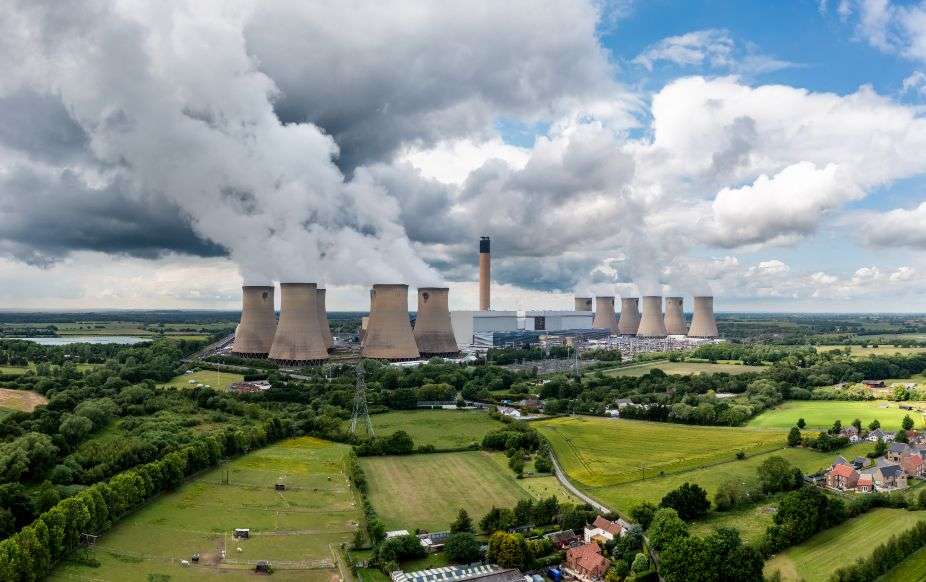In an era where sustainability and progress intertwine, the role of hydroelectric power plants stands as a shining example. As the demand for cleaner energy and economic growth continues to shape our world, hydroelectricity emerges as a powerful solution, addressing multiple facets of our modern needs. From low emissions and eco-friendly practices to the dual responsibility of water conservation and power generation, hydroelectric plants go beyond just producing energy. They foster job creation, offer stable costs, spur infrastructure development, and even create havens of tourism and recreation. Eager to uncover how it drives environmental well-being? Let’s embark on a journey to discover how hydroelectric power plants stand as beacons of clean energy.
- Reducing Emissions
- Green Power, Clear Skies
- Water’s Dual Role
- Powering Prosperity
- Consistent Energy Costs
- Infrastructure Development
- Nature’s Entertainment
Reducing Emissions

Greenhouse Gas Advantage
Hydroelectric power plants stand as champions in the fight against climate change, producing electricity with minimal emissions compared to their fossil fuel counterparts. By utilizing the kinetic energy of flowing water, these plants contribute significantly to reducing greenhouse gas emissions and curbing global warming.
Flipping the Script
Unlike traditional power sources, hydroelectric plants boast a spotless track record when it comes to air pollutants. With no combustion processes involved, they bypass the production of harmful particulates, sulfur dioxide, and nitrogen oxides that tarnish air quality and human health. Embracing hydroelectricity isn’t just an energy choice – it’s an environmentally conscious statement.
Emission Control
The construction of hydroelectric dams and reservoirs not only facilitates power generation but also addresses the emission issue from a different angle. By managing water flow and preventing floods, these structures contribute to overall ecosystem stability, safeguarding natural carbon sinks like forests and wetlands.
A Symphony of Benefits
Hydroelectricity dances to the tune of clean energy, creating a harmonious blend of reduced emissions, renewable power, and environmental preservation. Its role in emission reduction goes beyond electricity generation, extending its reach to water management, ecosystem protection, and climate resilience.
Breathing Easier
By reducing the need for fossil fuel combustion, hydroelectric power plants contribute to cleaner urban air. The absence of harmful emissions like sulfur dioxide and nitrogen oxides not only benefits human health but also enhances the beauty of city skylines by reducing smog and haze.
A Ripple Effect on Carbon Footprints
The positive effects of hydroelectricity on emission reduction are felt beyond local communities. By providing a low-carbon energy solution, these power plants contribute to international efforts to mitigate climate change. The ripples of their impact extend far and wide, as cleaner energy practices become a global aspiration.
Green Power, Clear Skies

Powering Change
Hydroelectric power plants stand as iconic symbols of eco-friendliness, harnessing nature’s flow to generate electricity without leaving a heavy carbon footprint. This commitment to sustainability transforms them into beacons of hope for a greener energy future.
Nature’s Collaborators
Hydroelectric plants demonstrate their eco-friendliness by prioritizing coexistence with local ecosystems. Careful design and management help preserve aquatic habitats, ensuring that aquatic life thrives alongside clean energy generation, contributing to biodiversity and overall environmental health.
Emission-Free Energy
Embracing hydroelectricity means embracing clean, fresh air. Unlike fossil fuel-based power sources, hydroelectric plants don’t emit pollutants that mar the atmosphere. In their pursuit of generating electricity, they gift us with a breath of fresh air, making the environment a better place for all living beings.
Sustainable Synergy
Hydroelectricity’s eco-friendliness extends to water management, a crucial factor for both energy production and ecological balance. By effectively regulating water flow, hydroelectric plants prevent floods, ensure water availability, and contribute to the well-being of downstream communities and habitats.
Rivers of Resilience
Hydroelectric plants not only generate power but also play a role in climate resilience. By regulating water levels and preventing flooding, they contribute to safeguarding communities against the intensifying impacts of climate change, showcasing their eco-friendly approach to energy production.
Preserving Pristine Landscapes
Hydroelectric projects blend function with aesthetics, proving that eco-friendliness doesn’t mean sacrificing beauty. Dams and reservoirs become picturesque landscapes that harmonize with their surroundings, proving that clean energy generation can coexist with nature’s artistic touch.
Empowering Tomorrow
The story of hydroelectricity’s eco-friendliness goes beyond power plants. It’s about educating communities on the importance of embracing clean energy practices and advocating for sustainable choices. Hydroelectric projects become catalysts for discussions about environmental responsibility and a greener future.
Water’s Dual Role

Nature’s Bank
Hydroelectric power plants are guardians of water’s dual role—conservation and power generation. Flowing water, a renewable resource, becomes the driving force behind clean energy, ensuring both environmental sustainability and our energy needs are met.
The Reservoir’s Symphony
Dams and reservoirs, integral to hydroelectricity, perform a delicate dance between conservation and energy generation. They expertly control water flow, allowing us to harness the energy of moving water while also taming floods, ensuring a balanced coexistence with nature’s rhythm.
Balancing Act of Power Generation
Hydroelectric plants are masters of equilibrium, using water to produce electricity while minimizing harm to surrounding ecosystems. By striking this balance, they exemplify how sustainable power generation and environmental preservation can go hand in hand.
Harvesting Raindrops
One drop at a time, rainwater fills rivers and reservoirs, providing a source of energy for hydroelectricity. This dance of droplets showcases water’s dual role, simultaneously nourishing the earth and fueling our homes with clean, renewable power.
Water’s Journey
Hydroelectricity’s connection to water is a tale of dual significance. While controlling floods protects communities and landscapes, the same water currents are channeled to generate electricity, highlighting the multifaceted nature of water’s role.
Advancing Hydropower Technology
Innovative hydroelectric technologies embrace water’s dual role in revolutionary ways. From run-of-the-river designs to pumped storage solutions, these advancements maximize energy generation while maintaining respect for water’s conservation importance.
A Ripple of Inspiration
Hydroelectric plants go beyond their immediate impact, creating a ripple effect of conservation efforts that extend far and wide. These plants serve as powerful examples, showcasing the dual significance of water as both a lifeline and a source of energy. This demonstration serves as an inspiration, prompting individuals, industries, and even entire nations to take on the role of responsible stewards, fostering a broader culture of water-saving practices.
Powering Prosperity

Impact on Employment
As we dive into the world of hydroelectric power plants, it’s evident that their influence stretches far beyond the generation of electricity. These plants serve as catalysts for job creation in communities fortunate enough to host them. The employment opportunities span a spectrum of professions, opening doors for individuals with diverse skills and backgrounds.
Engineering and Employment Hubs
The construction phase of hydroelectric projects is a testament to human ingenuity. Engineers, architects, and skilled laborers come together to bring these monumental structures to life. These projects aren’t just feats of engineering; they double as vibrant employment hubs, drawing in workers from various disciplines and invigorating the local workforce.
Maintenance Careers
Once the grand turbines start spinning, an entirely new realm of employment emerges. Skilled technicians, mechanics, and experts in plant operations ensure that everything runs like clockwork. From routine maintenance to troubleshooting, these individuals are the gears that keep the machinery humming, contributing their expertise to the efficient and reliable production of clean energy.
Empowering Entrepreneurs
The ripple effect of hydroelectric projects extends to adjacent businesses. As these plants bring in employees and visitors, a thriving ecosystem of restaurants, accommodation providers, and service-oriented establishments springs up to meet the needs of the influx. This symbiotic relationship empowers local entrepreneurs while enhancing the overall appeal of the region.
Educating the Future
Beyond physical jobs, hydroelectricity drives knowledge-based opportunities. Educational institutions tailor programs to meet the demands of this dynamic field, preparing a skilled workforce capable of maintaining, innovating, and advancing hydroelectric technology. By fostering education, these plants create a legacy of expertise that propels the industry forward.
Diverse Employment Opportunities
Hydroelectric plants are equal-opportunity employers, embracing a wide spectrum of skills. From hands-on blue-collar roles to analytical white-collar positions, they cater to a diverse workforce. This inclusivity strengthens local communities, enriching them with a tapestry of talents and contributing to the overall vitality of the region.
National Economies
The economic currents generated by hydroelectric plants have a wider impact. As employment opportunities grow, they shape not only local economies but also contribute to the stability and growth of entire nations. The revenue generated from energy sales, employment taxes, and infrastructure development creates a positive feedback loop that enriches the fabric of society.
Consistent Energy Costs

Water-Powered Assurance
In a world where energy costs can be as unpredictable as the weather, hydroelectric power plants emerge as beacons of stability. Unlike fossil fuels, which are subject to market volatility and geopolitical tensions, hydroelectricity relies on the constant flow of water, providing a consistent energy source that keeps costs steady.
A Priceless Resource
The secret behind hydroelectricity’s steady pricing lies in its utilization of nature’s flow. The perpetual motion of water is harnessed to turn turbines, generating electricity without the need for fluctuating fuel prices. This reliance on a renewable resource creates an energy supply that is not only consistent but also sustainable.
Bypassing Fuel Price Roller Coasters
For consumers, the impact of fluctuating fuel prices can be daunting. Hydroelectricity offers a welcome respite from these price roller coasters. With stable energy costs, households can budget more effectively, freeing them from the anxiety of unpredictable energy bills that can strain finances.
A Competitive Edge
Industries often require substantial energy inputs for operations, making energy costs a significant factor in decision-making. Hydroelectricity’s consistent pricing provides industries with a competitive edge, enabling them to plan and strategize without the specter of sudden cost spikes affecting profitability.
Reducing Price Shocks
Hydroelectric dams act as guardians against energy price shocks. During times of turmoil in conventional energy markets, the steady flow of hydroelectric power remains unaffected. This stability contributes to economic resilience, shielding societies from sudden and disruptive energy price shocks.
Weathering the Storms
Global events, geopolitical tensions, and oil market fluctuations can send shockwaves through energy markets. Hydroelectricity, with its reliance on local water resources, remains remarkably resilient to these external factors. It stands as a bulwark of energy stability, providing reassurance in an uncertain world.
A Journey of Empowerment
Embracing hydroelectricity is a strategic choice that empowers societies to navigate future energy landscapes with confidence. By investing in this renewable and consistent energy source, communities prepare themselves for a future where energy costs are not a source of concern but rather a stable foundation for growth and prosperity.
Infrastructure Development

Infrastructure’s Dual Role
Beyond the flow of energy, hydroelectric power plants carry an often-underappreciated role as catalysts for comprehensive infrastructure development. These projects require a symphony of engineering marvels, from the construction of dams and reservoirs to the creation of roads, bridges, and transmission lines that traverse challenging terrains.
Pillars of Connectivity
Hydroelectric projects carve paths through rugged landscapes, connecting remote areas to urban centers. The construction of roads and bridges not only facilitates the transport of heavy machinery during construction but also remains an enduring pathway that enhances accessibility for local communities, tourists, and researchers.
Sparking Progress
While hydroelectric power plants generate electricity, an equally crucial aspect is delivering that power to homes and industries. Transmission lines, often stretching across picturesque landscapes, efficiently transport electricity to distant areas, contributing to a more interconnected and powered world.
Local Flourish
Infrastructure development linked to hydroelectric projects isn’t confined to concrete and cables; it extends to local economies. As construction workers, engineers, and supporting services are employed, communities witness economic upturns. Simultaneously, new roads and improved connectivity invigorate tourism, trade, and business opportunities.
Reshaping Landscapes
The creation of reservoirs for hydroelectricity purposes transforms terrains, turning valleys into vast water bodies. These reservoirs become recreational havens, attracting visitors for fishing, boating, and leisure activities. The coexistence of energy generation and recreation showcases the multifaceted nature of hydroelectric projects.
Balancing Development and Preservation
The development of hydroelectric infrastructure is a harmonious blend of progress and preservation. Engineers and ecologists work in tandem to ensure the environment remains unharmed. The construction and operation of these plants often involve intricate environmental impact assessments and mitigation measures.
Legacy of Infrastructure
Long after the turbines spin and the energy flows, hydroelectric infrastructure remains a legacy. Dams, reservoirs, roads, and transmission lines continue to shape landscapes, economies, and societies. They stand as monuments to human innovation and perseverance, illustrating how progress can be achieved without sacrificing the environment.
Nature’s Entertainment

A Natural Attraction
Hydroelectric power plants not only harness energy; they also create alluring landscapes that beckon outdoor enthusiasts. The reservoirs formed by these plants transform into serene havens for fishing, kayaking, and boating. The gentle lapping of water against the shore becomes a soothing symphony, drawing visitors into nature’s embrace.
A Recreational Haven
The tranquil waters of hydroelectric reservoirs become a canvas for fishing enthusiasts. The promise of a big catch, surrounded by the picturesque backdrop of dams and lush landscapes, transforms fishing into a delightful adventure. Anglers cast their lines, creating stories that intertwine with the hum of clean energy generation.
Navigating the Currents of Beauty
Boating across the crystal-clear expanse of hydroelectric reservoirs is an experience like no other. With the imposing presence of dams and the untouched beauty of nature, these waters offer a unique blend of adventure and serenity. Whether it’s kayaking, canoeing, or leisurely cruising, hydroelectric sites become gateways to aquatic exploration.
Energizing Tourism
Hydroelectric projects aren’t just about power; they’re about powerfully captivating tourism. The scenic allure of these sites draws visitors seeking relaxation and adventure alike. Tourists not only witness the marvels of energy production but also immerse themselves in the landscapes that have been gently shaped by human innovation.
The Thrills of Adventure
Hydroelectric sites aren’t confined to water; they often feature sprawling landscapes ripe for exploration. Hiking trails wind through forests, leading visitors to breathtaking viewpoints that offer panoramic vistas of reservoirs and dams. This fusion of human engineering and untouched nature ignites a sense of wonder and adventure.
Learning Through Exploration
Hydroelectric sites serve as living classrooms, offering insights into clean energy generation and the delicate balance between development and environmental preservation. Guided tours educate visitors about the inner workings of power generation while nurturing an appreciation for nature’s resilience.
Tourism’s Ripple Effect
The influx of tourists to hydroelectric sites generates more than admiration; it bolsters local economies. Nearby communities benefit from increased tourism-related businesses, such as accommodations, restaurants, and guided tours. Hydroelectric power plants become not only generators of energy but also sources of economic vitality.
In the grand symphony of progress, hydroelectric power plants stand as the conductor, orchestrating clean energy and economic growth in harmony. Their low emissions, eco-friendly practices, water conservation efforts, job creation potential, stable costs, infrastructure development, and allure for tourism and recreation collectively compose a masterpiece of modern sustainability. As we continue to tread the path towards a greener and more prosperous future, the role of hydroelectricity remains pivotal. Let us join hands in championing this remarkable source of energy and economic vitality. Ready to embark on a journey of discovery? Explore the intricate workings of hydroelectric power plants and witness firsthand how they illuminate a path toward a cleaner, more prosperous world.
